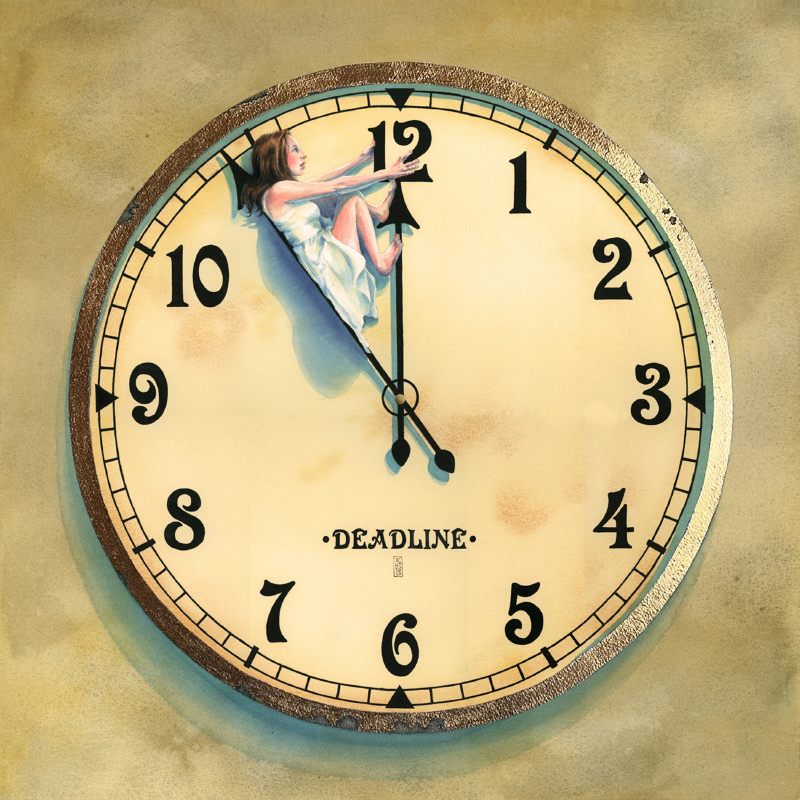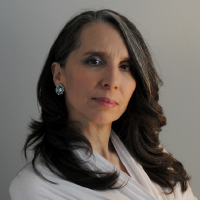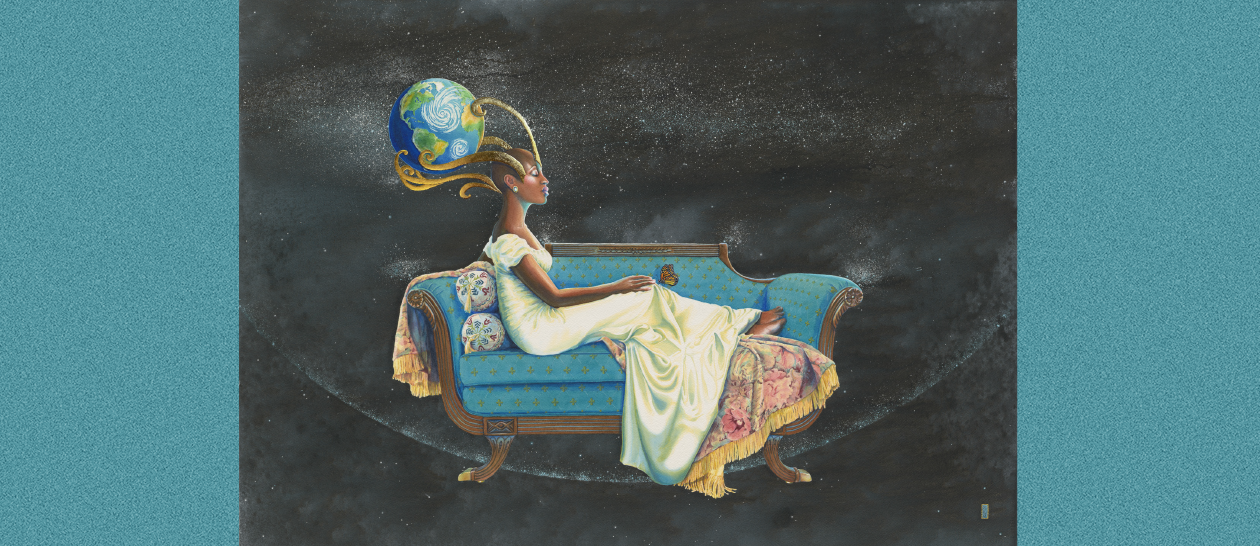J.C. LITTLE is a Canadian artist and former animator known for her expressive watercolors and storytelling. Here, she is interviewed by PURNIMA RAMAKRISHNAN. She shares how art serves as meditation and reflects on two of her standout works—Momentum, a celestial painting on inner transformation, and Deadline, a poignant take on time and womanhood.
Q: Do you see art as a form of meditation? When I look at certain art, I feel a kind of meditative stillness in it.
JCL: I think so. There’s a popular way of describing it, where you get in the zone as you’re executing art.
For me, it starts before that. I’m one of these people who suffer from an overactive imagination. I’m always being assaulted with ideas and concepts, and in my mind, I’m turning them over and seeing how to tell that story. Is it funny? Is it wordplay? Is it emotional? At the back of my mind, I’m percolating on these things that I want to turn into images.
When you finally get to the point where you’re executing something, there’s an element of discovery in it. We may not have completely worked out the solution to what we are looking for, the actual creative expression, but most of that work is already done in my head. That can become extremely meditative. It can also be problematic because we can get lost in it.
I have a little escape hatch, which is my dog. It keeps me from working on and on into the small hours of the night. The answer to your question is yes, definitely, there is a meditative aspect. Several aspects.
Q: How was your journey from being a cartoon artist to a person who does beautiful paintings? Has your creative process changed? How has this evolution changed you as a person?
JCL: I have always mixed the two, ever since I was a small child. My parents knew I could draw, so they were always getting me art supplies for every birthday and Christmas. Whenever it was time for presents, I got art supplies. I was given art lessons, lots of art lessons. As a kid, I just wanted to do funny drawings.
When I was a child, we lived in Montreal in Canada. When I was 11, we moved to Hong Kong. A couple of things happened. The first was that my parents immediately put me in Chinese brush painting classes. That’s where I was very impressed by the dispersion of pigment in water. That was my first real structured introduction to watercolors. The second thing that happened was that my little brother went to the hospital for surgery on his legs. Seeing him in recovery was a great motivation for me to draw funny pictures for him, to make him laugh and cheer him up.
I grew up and went to university to study graphic design and illustration. Later, I met an animator and became an animator. For decades, I worked in animation, and that’s a different kind of creativity.
All the while, I was still drawing and sketching, but not focusing on fine arts. My animation career turned into The Animated Woman, which was my blogging site where I finally did my own TV series. I worked for three or four years, 90 hours a week. I just needed a break from that and wanted to get my little creative ideas out. The fastest way to express all the ideas from my overactive imagination was to do stick figures digitally. I did conceptual things, little jokes about family life. That became my blog.
I did quite a few short animated films using these stick figures, but I also did a lot of what I call sequential art, illustrated books for children, my own books that I self-published. A lot of that art was on my blog. My blog, The Animated Woman, was drawings like that.
I was forced to simplify a concept or a feeling or a story into the most poetic form. They weren’t always funny, sometimes they were quite tender, playful, or sad, evoking tears. When I went back into watercolors, it was a natural progression for me to take these single-image stories and turn them into full paintings.

All my concept drawings start as these very simple stick figures. Let me show you my sketchbook. I did a lot of color studies. You can see how I started with a very rough face and then refined it, how I was going to handle the gold leaf, what pigments I was going to use, how I was going to do the dress. I work all of that out in my sketchbook. My painting, Momentum, was special because it’s really big for a watercolor.
Q: Momentum is one of the most fabulous paintings I’ve really seen.
JCL: That’s good to hear. That painting was special because I had the idea and was thinking of using my friend Tracy. She agreed to pose for me. It started out as just the woman on the sofa. There are many paintings of a woman on a sofa, many, many paintings. It’s a popular subject. But I wanted to show her imagining the planet, imagining the world, maybe even reimagining the world. Contemplating the world, and showing a kind of transformative, contemplative state with the butterfly.
To make her more of a creator or give a kind of celestial vibe, I decided she should have all the space she wants. I literally put her in outer space. This painting was different from everything I had done before in its size, but it was a continuation of the painting Deadline with the clock. That was going more in a direction of magical realism, where you depict things rendered in a realistic way, but there’s no way they could be real. There’s no way a woman sits in outer space on a sofa imagining.
I don’t want to be limited by reality because I come from the world of animation, where we can do anything. The scope of it, the size of it, meant I couldn’t use my usual brushes for the background. I had to use a completely different technique to approach the background, because I didn’t want to see brush marks. In fact, I painted the painting three times, not the full painting, but mainly the background. The first two times, it wasn’t what I wanted. I discovered a way to move the paint around without using brushes. I used a special technique. I put a lot of water on the paper, then put the pigment on top and moved it around. It worked out in a way that gave this beautiful galactic feeling. The background is pretty much done in one layer of paint.
I think a lot of people really related to this painting
because it talks about several themes: women, our bodies,
and how we are running out of time.
With watercolor, it’s really difficult to make larger paintings. When they’re small, you can use a certain sized brush. The hairs on a brush are a certain thickness, and if you get a bigger brush, it doesn’t behave the same way. This is all technical stuff about watercolor, getting things to behave, inducing behavior in watercolor, which really just wants to do its own thing. You want to let it do its own thing.
It lends itself to magical realism very easily. I just love that about this medium. It’s a very honest medium. It’s impossible to lie with it. You can’t cover things up. There is not a drop of white paint on that painting. It is all the whites of the paper shining through, the stars, everything. That makes it really luminous. That’s what I love about that painting.
Q: I also liked your painting Deadline, this lady sitting between the minute hand and hour hand. Somehow I felt that was me, and then I thought, perhaps everyone thinks that is them.
JCL: I think a lot of people really related to this painting because it talks about several themes: women, our bodies, and how we are running out of time. Society places a lot of pressure on us to stay young or be reproductive. We have our reproductive deadline, your body clock is going to run out. There’s also work, and how we impose these deadlines upon ourselves, to finish things on time or to achieve things. I think it has universal appeal in how people relate to it.
To purchase J.C. Little’s paintings directly from her website, please visit https://www.jclittleportraits.com/


